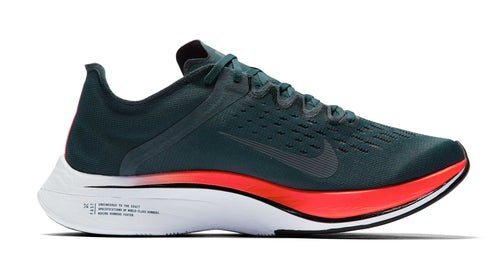A few weeks ago, Grand Valley State University researcher �� which concluded that Nike’s controversial Vaporfly 4% shoe gives runners an efficiency edge of 4.2 percent compared to Adidas’s state-of-the-art marathon racing shoes, the Adizero Adios 3. I checked in with my editor to see whether I should write about the new results, but she was lukewarm about it. After all, the 4-percent claim isn’t news—it’s right there in the name of the shoe, was confirmed by peer-reviewed external testing at the University of Colorado (which I already wrote about last year), and backed up by of half a million marathon and half-marathon race times posted to Strava.
In other words, we already pretty much know that it’s true. To be fair, there are a bunch of interesting new wrinkles and twists in the Grand Valley study. Crucially, unlike the Colorado study, it wasn’t funded by or affiliated with Nike, Adidas, or any other shoe company. It also found that the Vaporfly was 2.6 percent more efficient than Nike Zoom Matumbo track spikes, and observed an average improvement of 1.90 percent in 3,000 and 5,000-meter track times—new territory for a shoe that’s mostly been marketed to marathoners. But the basic claim that the Vaporfly allows you to burn significantly less energy to run at a given pace is now pretty widely accepted.
Instead, the debate has moved on to two trickier questions. First, how exactly do the shoes work? And second, should they be allowed? Those two questions are tightly intertwined, because of the perception that the curved carbon fiber plate embedded in the shoe’s midsole acts as a spring. But there’s been surprisingly little consensus, even among the shoe’s designers, about how the Vaporfly’s various components actually work. So that makes another new study, from the same Nike-funded University of Colorado team that tested the original 4-percent claim, an intriguing read.
The study, , used three-dimensional biomechanical stride analysis and force-plate measurements in an attempt to unravel what makes the Vaporfly so efficient. The shoe has two novel components. One is a super-thick cushioned midsole made of a new foam that Nike calls ZoomX. The foam is ultralight, allowing the heels to be 31 millimeters high at the heel, which is about 50 percent thicker than comparable shoes, without being heavier. It’s also exceptionally compliant (you can squish it) and resilient (it springs back to its original shape, returning most of the energy you applied to squish it). In a sense, every shoe with a midsole has a “spring” in it; this one just happens to be particularly springy.
The second novel component is a curved carbon fiber plate embedded within the midsole. This is where a lot of the controversy comes in. One school of thought is that the plate is simply a spring, bending as your foot lands and then catapulting you forward as it springs back into position. Back in 2016 when rumors about the shoe first began to circulate, for a “footwear sole structure including a spring plate” began to , fueling rumors that Nike had a spring-loaded shoe. This patent to be for a different (and so far unreleased) shoe design, but the idea stuck. Most people now assume the Vaporfly is powered by its carbon fiber spring.
But that’s the not the theory I heard when the shoe was finally released and I started calling around to ask shoe biomechanists what they thought. It turns out that researchers (and other shoe companies) have been playing around with carbon fiber plates since at least the 1990s. The most direct precursor to the Vaporfly’s plate is Adidas’s ProPlate, which appeared in the early 2000s and was developed by University of Calgary researcher Darren Stefanyshyn. (One of Stefanyshyn’s former Ph.D. students, Geng Luo, led the design of the Vaporfly and appears on .)
Back in 2006, Stefanyshyn his explanation for the how the carbon fiber plate works. When you run, you spend some energy bending your main toe joints. Unlike your ankles and foot arch, which bend and then spring back into position, you don’t get any energy return from your toes—it’s wasted. Stefanyshyn showed that a stiff carbon fiber plate keeps your toes straighter, saving that energy and improving running economy by about 1 percent.
But there’s a problem with this approach, Luo explained to me when I was reporting on the Breaking2 project last year. A stiff plate keeps your toes straight, but it forces your ankle to do more work, counteracting some of the overall efficiency benefits. The solution Luo and his team came up with was a plate with a more exaggerated bend in the forefoot, allowing the toes to roll forward without adding work for the ankle. This is the explanation Nike provided in their patent filing: a stiff plate to save wasted energy from toe-bending was already known, but their innovation was curving the plate to reduce forces at the ankle.
That’s not the only possible explanation, though. Another group, at the German Sport University in Cologne, led by an ex-decathlete named Steffen Willwacher, started studying carbon fiber insoles long before the Vaporfly was released. Their explanation of how this type of insert works, , is that the stiff plate basically changes the length of the lever between your ankle and where your foot pushes into the ground. That, in turn, changes the “gear ratio” between the internal lever arm of your muscles and tendons and the external lever arm of your ankle and foot, giving you a mechanical advantage in much the same way that the gears of a bike do. That’s not an explanation that’s easy to wrap your head around (at least it wasn’t for me), but it’s one I heard from a bunch of different biomechanists.
The new experiment, from Wouter Hoogkamer, Shalaya Kipp, and Rodger Kram of the University of Colorado’s Locomotion Lab, involved 10 runners who ran five-minute trials in three different shoes: the Vaporfly, Nike’s Zoom Streak 6, and Adidas’s Adizero Adios Boost 2, the latter two being state-of-the-art traditional marathon racing flats. Each runner had 44 reflective markers taped to their body and shoes for three-dimensional analysis of their running motion; they ran on a special treadmill that measured the forces as their feet hit the ground. This enabled them to calculate the angles, forces, and work done for each joint.
The properties of the shoe were also measured separately by a “rotational axis material testing machine” that bent the shoe lengthwise while simulating a running motion to estimate its bending stiffness. By combining the stiffness of the shoe with the forces hitting the treadmill and the relative movement of the reflective markers, the researchers could estimate exactly how much the shoe (and the stiff plate inside) compressed and bent—and, consequently, how much energy was stored and returned with each stride by different components of the shoe.
The results were somewhat unexpected. The bending of the carbon fiber plate stored and returned energy at a rate of 0.007 watts per kilogram with each stride. In comparison, the squashing and unsquashing of the thick ZoomX foam returned 0.318 W/kg—more than twice as much as either of the other shoes, and about 45 times more than the plate. So the shoe definitely functions like a spring, but in this analysis it’s the foam midsole rather than the stiff plate that makes almost all the difference in the shoe’s contribution to energy savings.
As for the other theories, running in the Vaporfly did indeed seem to save some energy that would otherwise be lost to toe-bending. But the magnitude of the savings was small enough that Hoogkamer and his colleagues don’t think it makes a major��contribution to the 4 percent boost in running economy.
Instead, there seem to be more significant energy savings at the ankle joint—but not quite in the way they expected based on the “gear ratio” theory. The theory predicts that the Vaporfly will produce a larger rotational force at the ankle; the data, in contrast, showed a smaller rotational force. There are some long passages in the paper that explore why the result was the opposite of what they expected yet still produced an energy savings. I’ll summarize those passages loosely as follows: They’re not sure what’s going on.
So that’s where we stand for now. There are several other studies in the pipeline from Barnes and others that will give us further insights on how these shoes work. For now, we can say two things. One is that the shoes change how efficiently you’re able to lever force into the ground, in some way that’s not yet clear. The other is that the shoes act as a spring—but only in the way that virtually all shoes act as a spring, by having a soft midsole. Kram’s back-of-the-envelope guess that the foam midsole gives a 3 percent boost, and the carbon plate adds another 1 percent. But the math may not be that simple: there may be some synergy between the foam and plate that makes the whole greater than the sum of its parts.
The ideal test would be to try a Vaporfly with no carbon fiber plate and see what happens. Would it be like running on giant floppy marshmallows, or would it be just as good as the real thing? “We have wanted to test this for quite some time, but haven’t been able to get such prototypes,” Hoogkamer told me in an email. “I personally think that a big, thick ZoomX stack without a plate would be a lot less stable, specifically taking 90-degree turns at Kipchoge speed. I don’t think it will be too soft, but hard to say without testing it.”
As for other big question of whether they should be banned, the Colorado study makes an important point. It’s not enough to say “Shoes shouldn’t have springs in them, so we should ban springs,” because you have to define what you mean by springs. If it’s really the ZoomX foam that makes the biggest difference, then banning carbon plates will miss the mark. If it’s the angle and shape of the carbon plate that provides the magic, then setting an upper limit on midsole thickness or resilience will also miss the mark. To figure out what you need to ban, you have to have a clear idea of what it is that’s objectionable—beyond the mere fact that the shoes seem to work.
My new book, , with a foreword by Malcolm Gladwell, is now available. For more, join me on and , and sign up for the Sweat Science .


